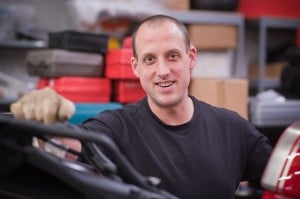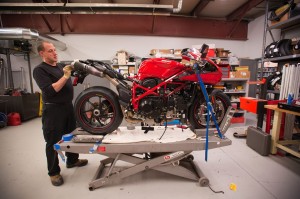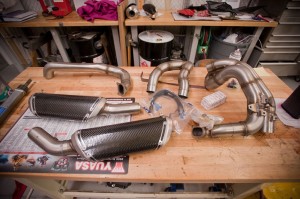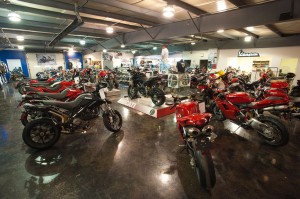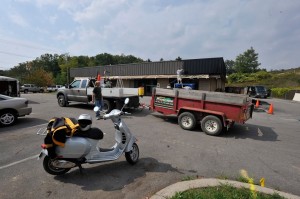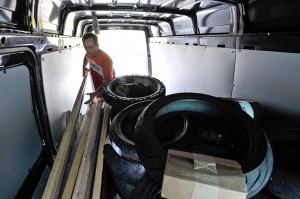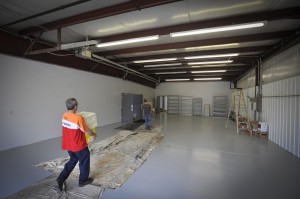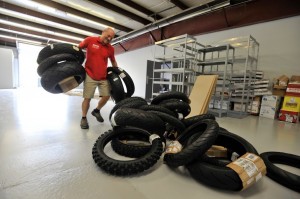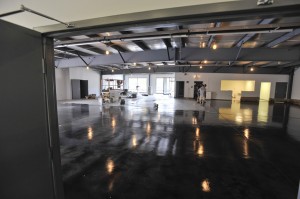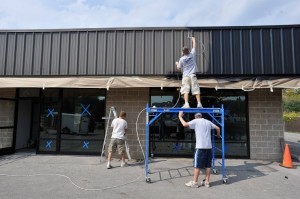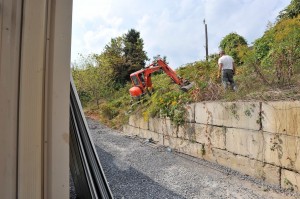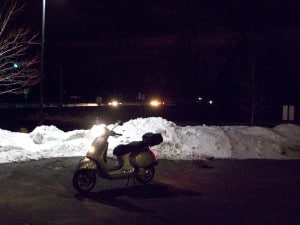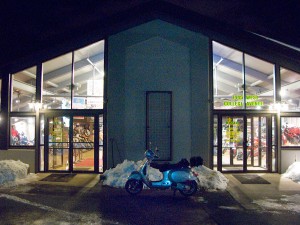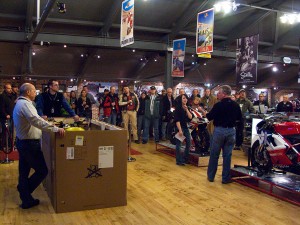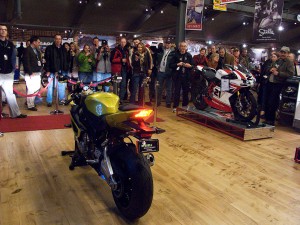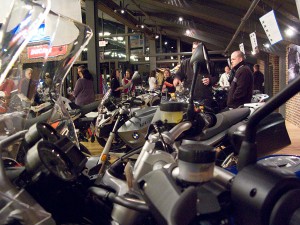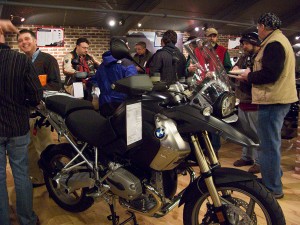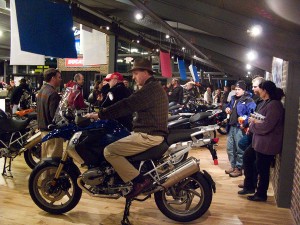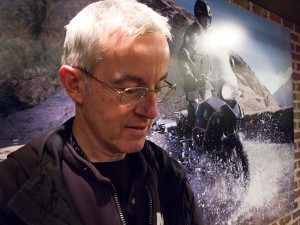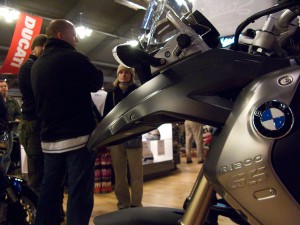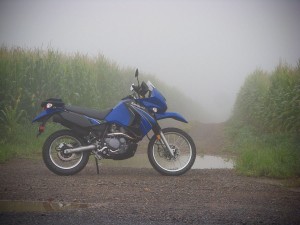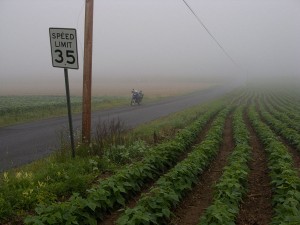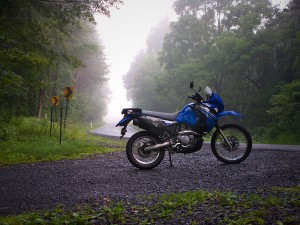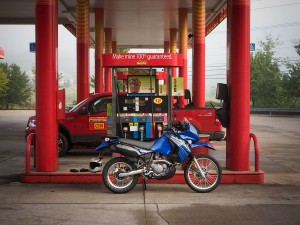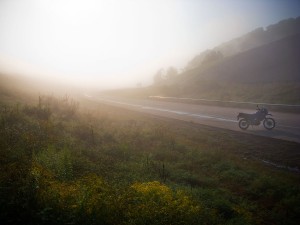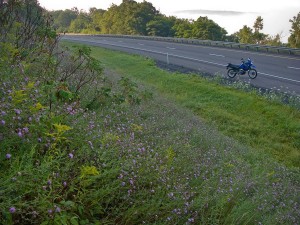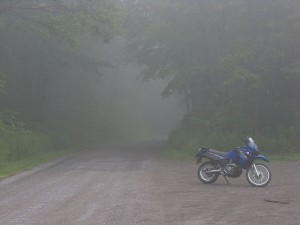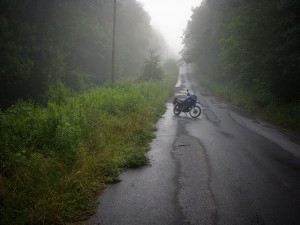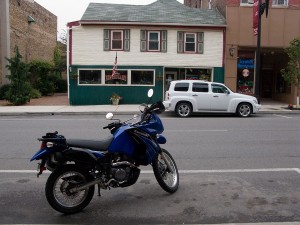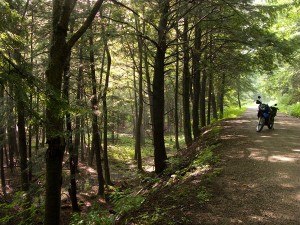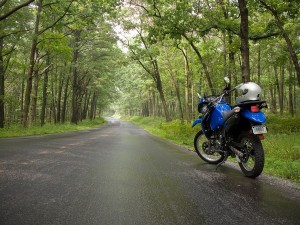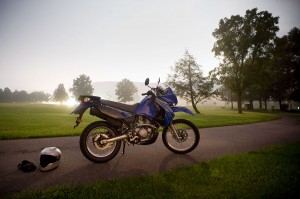That’s Tom Christensen, motorcycle mechanic.
Whenever I leave my Vespa for service at Kissell Motorsports I didn’t really know what was happening to it or who was doing the work. The scooter would be left behind and then, as if by magic, it would be returned with whatever mechanical needs addressed. For some people that would be enough. I got it into my head that I wanted to know the people who were evaluating my machine, turning the wrenches, and actually working on the Vespa. Or maybe I had a desire to enter the Employees Only realm, pull the curtain aside, and become part of the secret world of motorcycle service. So I suggested to Craig Kissell that it would be a good idea for me to interview the technicians, put a human face on that part of his business. About six weeks ago I took a step over the line and told Tom that I was going to interview him.
Meeting your mechanic is sort of like going to the dentist. You know you have to go but you’re afraid of what he’s going to say. They have a special power of life and death over motorcycles and scooters and I treat them accordingly. Something short of a blood sacrifice. My friend Paul would offer a box of Dunkin Donuts. I completely drop the ball and show up with a camera and the voice recorder in my iPhone.
One thing I tell would be riders when asked the ago old question, “What kind of scooter or motorcycle should I buy?” is to buy something you can have serviced by a local mechanic. Everyone can define local in his or her own way. For instance, BMW riders feel a local mechanic is someone within a day’s ride. So about 1000 miles. My definition puts them a bit closer. Either way, make sure you have a mechanic who can work on your bike before you buy it.
Having a good mechanic means more time to ride and less time involved in transporting a bike around. No one needs to remind me about the notion of spare bikes.
So I’m talking to Tom, trying to act cool and knowledgeable and hoping he doesn’t remember my unfortunate attempt to change the drive belt on my LX150. Detecting no smirks I move ahead with the interview. He’s putting a new, high performance exhaust system on a shiny red Ducati.
STEVE: So, how did you become a mechanic?
TOM: Everyone in my family is a mechanic. I started when I was five years old. My brothers and dad taught me. That’s how I learned about engines and stuff. I went to the Motorcycle Mechanics Institute in Arizona to get the credentials.
(At this point I’ve run out of questions. Tom seems content and isn’t offering anything more. Just as I prepare to wind up the interview he continues.)
TOM: My dad’s blind. He’s the local lawn mower repairman and is pretty good at listening to engines and fixing them by what he hears.
STEVE: How does listening fit into motorcycle repair?
TOM: You feel things through listening. The sounds tell a story. I end up making a lot of motorcycle noises.
(He starts making some remarkably mechanical sounds.)
TOM: That’s a Ducati.
(I hear a couple snickers from other guys in the shop and wonder if I am about to be the punch line to a joke. Tom must have sensed my complete and utter mechanical incompetence and would believe anything he said.)
TOM: Like those guys on CarTalk, Click and Clack, they’re always asking people to make the noise their car is making.
(He makes another noise that sounds like a transmission problem.)
TOM: You can figure out a lot of things about a problem if you learn to listen carefully. It’s not all about computers. That’s where the passion comes in. For a mechanic to diagnose a problem he often needs to hear the sound, whether it’s a clank clank clank, a clunk clunk clunk or a boing boing boing. That’s where my noise making comes from.
(The other guys in the shop have stopped what they were doing as if something was about to happen when one of them tells me to ask him about Karl. Tom stops what he’s doing and his face transforms into another person, someone I recognize but can’t quite remember until he suddenly breaks into a perfect rendition of Karl Childers, the character made famous by Billie Bob Thornton in SlingBlade.)
TOM: I like them French fried potaters.
If you don’t know of Sling Blade check out the video below. The main character, Karl, is an engine expert, hence the connection to a mechanic:
(Everyone cracks as he continues. Standing in the shop I feel like I have entered a David Lynch film and look around for Frank Booth. After a couple minutes of Sling Blade I ask another question.)
STEVE: What’s the easiest bike to work on here?
TOM: A Triumph is probably the easiest bike to work on. Straightforward, simple, reliable engineering. But my favorite bike to work on is a Ducati. I love the sound, the feel, the passion that goes into their creation. Every nut and bolt and fastener is well thought out and engineered. Every connection and cable and wire is chosen with excellence in mind.
(He begins speaking in tongues.)
TOM: There’s nothing like the sound of a Ducati.
(He shows me the new exhaust he’s installing on a Ducati 1198S.)
TOM: These pipes are all hand made stainless steel.
STEVE: I think they’re the same diameter as the exhaust on my Ford Ranger.
TOM: Come on, let me show you something.
(We head across the shop and go outside. I’m trying to think how to segue from the Ducati to the Vespa as we stop in front of a Ducati 796 with a newly installed exhaust system. I can tell he’s passionate about motorcycles and what makes them tick.)
(Back in the shop I shift gears.)
STEVE: So, what should riders be thinking about now that’s its spring. What should they be doing to get ready to ride?
TOM: Well, other than checking the air in their tires they should have done everything last fall when they stored their bike for the winter. This time of year I’m busy with carb cleaning and spark plug changes because gas was left in the motorcycle over the winter and when they started it up things got fouled.
STEVE: What do you suggest?
TOM: If you did leave the gas in all winter it would be a good idea to drain the float bowl before you try and start the motorcycle. Because once you try and burn that bad gas, well….
(I’m still trying to move the conversation towards the Vespa when it dawns on me that maybe Tom rides one himself!)
STEVE: What do you ride?
TOM: I have a SuperMoto conversion bike, a Honda XR650R liquid cooled Baja bike. (To some this bike is known as the biggest, baddest dirt bike ever) I put on Supermoto wheels, made it road legal, custom suspension, new bars and bar ends, lowered the front…
(I’m wondering what he must think of the scooter I’m riding. Just outside the shop door are a lot of Ducati motorcycles. BMWs, Triumphs, and Vespa scooter too. Just in case you need one.)
TOM: It’s the bike I always wanted; I like the dual sport, moto bikes. Sometimes I wish I would have waited for the Hypermotard but the one I have is great. Light, flickable. A SuperMoto bike is ideal for the kind of back roads we have here in central Pennsylvania.
(He’s putting a muffler on the Ducati and I’m looking around, searching for a way to bring up the Vespa.)
TOM: I can’t believe how many miles you put on your Vespa. Not many people do that.
(As if by magic my spine has straightened. I think I hear trumpets echoing in the distance.)
STEVE: It’s a good machine. It’s been pretty reliable.
TOM: You make sure it’s serviced properly. That makes a big difference.
STEVE: Yeah. You guys do a good job with it.
(And that’s how we ended the interview.)
I got to finally talk with one of the mechanics at Kissell Motorsports for more than a minute or two. When I was riding the BMW R100 GS last week Tom personally checked it out and provided his assessment of the bike – a big thumbs up. When I returned it he seemed as surprised as everyone else that I was going to remain a scooter rider.
Some things defy human understanding.
Regardless, Tom can work on the Vespa anytime.
